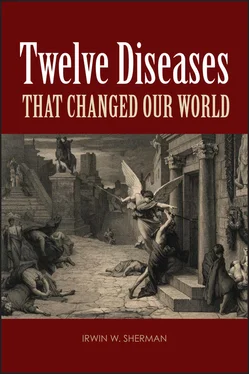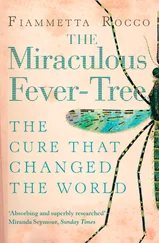Irwin W. Sherman - Twelve Diseases that Changed Our World
Здесь есть возможность читать онлайн «Irwin W. Sherman - Twelve Diseases that Changed Our World» — ознакомительный отрывок электронной книги совершенно бесплатно, а после прочтения отрывка купить полную версию. В некоторых случаях можно слушать аудио, скачать через торрент в формате fb2 и присутствует краткое содержание. Жанр: unrecognised, на английском языке. Описание произведения, (предисловие) а так же отзывы посетителей доступны на портале библиотеки ЛибКат.
- Название:Twelve Diseases that Changed Our World
- Автор:
- Жанр:
- Год:неизвестен
- ISBN:нет данных
- Рейтинг книги:5 / 5. Голосов: 1
-
Избранное:Добавить в избранное
- Отзывы:
-
Ваша оценка:
- 100
- 1
- 2
- 3
- 4
- 5
Twelve Diseases that Changed Our World: краткое содержание, описание и аннотация
Предлагаем к чтению аннотацию, описание, краткое содержание или предисловие (зависит от того, что написал сам автор книги «Twelve Diseases that Changed Our World»). Если вы не нашли необходимую информацию о книге — напишите в комментариях, мы постараемся отыскать её.
Twelve Diseases that Changed Our World — читать онлайн ознакомительный отрывок
Ниже представлен текст книги, разбитый по страницам. Система сохранения места последней прочитанной страницы, позволяет с удобством читать онлайн бесплатно книгу «Twelve Diseases that Changed Our World», без необходимости каждый раз заново искать на чём Вы остановились. Поставьте закладку, и сможете в любой момент перейти на страницу, на которой закончили чтение.
Интервал:
Закладка:
The monarchists in Spain pressed Franco to restore the monarchy. Indeed, monarchism was strong among the generals who had backed him. However, Franco feared that restoration of a liberal constitutional monarchy would be both anti-Catholic and anti-Nationalist. Further, the possible royal heirs were now living in exile. Alphonso, the eldest son, who inherited the hemophilia gene from his great grandmother Queen Victoria, renounced his claim to the throne in order to marry a commoner, although his removal from the succession as a result of his hemophilia was already being considered. He died at age 31 from a hemorrhage after a car crash. Gonzalo, the youngest son and another hemophiliac, died at the age of 19, also from an uncontrollable hemorrhage after a car accident. Jaime, the second son, who had been deaf since a childhood operation for mastoiditis, renounced his claim to the throne on the grounds of his disability. The remaining son, Juan (the father of the present king of Spain, Juan Carlos), was the only healthy son who survived to adulthood. The number of potential heirs was therefore very limited. The Nationalists, under Franco, received strong support from Italy and Germany, and by April 1939 they were victorious. From the 1940s onward, Spain was under the influence of what Franco liked to call “national Catholicism.” During World War II, Spain, although in sympathy with Hitler and Germany, remained neutral. For not taking sides and for Franco's pro-Fascist policies, Spain was ostracized by the Allies after the war, and this continued to adversely affect the Spanish economy. However, by the 1950s, Spain's economy improved as it opened its markets, and it became strategically important to Britain and the United States in the Cold War. Franco permitted the United States to build air and naval bases in Spain in exchange for economic and military aid. This helped in industrial expansion and improved the economy further. In 1955, Spain was admitted to the United Nations. From 1969 to 1973 there was an unresolved power struggle between the reformists and the conservatives. Miners and other workers went on strike, Basque terrorism increased, and Franco was aging and unwell. The situation was resolved in 1975: General Franco died on 20 November, and Juan Carlos (the son of Don Juan) was crowned King on 22 November. In the end, Franco's 30-year dictatorial regime was replaced by the liberal constitutionalism he had fought so hard against.
The influence of hemophilia during World War II
Leopold, the eighth child of Queen Victoria, was born on 7 April 1853. He was the only son to be affected by hemophilia. He bruised easily and suffered many bouts of internal bleeding. He became a chronic invalid with an abnormal posture. Victoria considered him unattractive, saying, “He is tall, but holds himself worse than ever, and is a very common looking child, very pale in face, clever but an oddity—and not engaging though amusing.” The Queen was so ashamed of Leopold that he was frequently left behind while the rest of the family went on holiday. Leopold used these times to read widely, and he was one of the most intelligent of Queen Victoria's children. The Queen recognized his intellectual capacities, and when he was 24 she made him one of her private secretaries with access to state papers, a privilege denied to his brother Edward Prince of Wales. In 1881, Queen Victoria made Leopold the Duke of Albany, and the following year he married Princess Helena of Waldeck, sister of the Dutch queen. The Duke and Duchess of Albany had a daughter, Princess Alice (a carrier of hemophilia), and a son, Charles Edward Leopold, who was born shortly after his father's death at the age of 31 from a cerebral hemorrhage after falling down a flight of stairs. Charles Edward Leopold could not inherit hemophilia from his father (see p. 9–10), but at the age of 16 he did inherit the dukedom of Saxe-Coburg and Gotha from his uncle Alfred, Duke of Edinburgh, and he rose to the rank of general in the German Imperial Army. With the collapse of Germany after World War I, he had to abdicate his dukedom; however, he was a prominent member of the Deutsches Nazionalist Volks Partie (DNVP) and helped forge an alliance between it and the Nazional Sozialist (Nazi) Partie. In 1933, when Adolf Hitler was elected chancellor, the DNVP disbanded and many of its members joined the Nazis. Charles Edward Leopold became a group leader in the Nazi Brownshirts. In 1936 Hitler sent him to Britain in his capacity as President of the Anglo-German Fellowship; his real mission was to assess the possibility of an alliance between the two countries. During his stay he met with his cousin Edward VIII and several high-level politicians. After his first meeting with Edward VIII in early 1936, Charles Edward Leopold reported to Hitler that the new King would be amenable to such an alliance and would exercise his influence to make this a “guiding principle of British foreign policy.” The Duke went so far as to report that Edward dismissed the need to discuss this with the Prime Minister, Stanley Baldwin. However, the Duke was not a reliable reporter, and his assertion was never confirmed by Leopold von Hoesch, the German ambassador to Britain.
In December 1936, Edward VIII abdicated (becoming thereafter the Duke of Windsor) to marry Wallis Simpson, an American divorcée. The following year, the Duke and Duchess of Windsor visited Germany, where the Duke met with Hitler, Goering, and Goebbels and greeted Hitler with a Nazi salute; his cousin Charles Edward Leopold celebrated the visit with a gala dinner in his honor. The cordial relationship between Hitler and the Duke of Windsor caused great consternation to the new King, George VI, and his government in the years before the outbreak of World War II. Early in the war, Germany unleashed a destructive air offensive against Great Britain. This was perceived by the Prime Minister, Winston Churchill, as a prelude to an invasion of Britain. The Duke of Windsor was reported to have recommended ending the war “before thousands more were killed or maimed to save a few politicians.” It was even rumored that Hitler was so intent on maintaining the Duke within reach of Germany that he contemplated either kidnapping or bribing him. In order to remove Edward from any German influence and to avoid having him in Britain, Churchill arranged for him to be appointed Governor of the Bahamas. In late July 1940, Hitler, through intermediaries, audaciously suggested that the Duke might return to the British throne if Germany was victorious; there is no evidence that the Duke responded to this proposal. The Duke hesitated before accepting the Governorship of the Bahamas, partly because of German-inspired rumors that the British Secret Service was planning to assassinate him once he arrived there. He eventually accepted the post and sailed for Nassau in August 1940.
Meanwhile, Charles Edward Leopold provided encouraging, if greatly exaggerated, reports to Hitler on the pro-German party's strength in Britain, reinforcing Hitler's hope that Britain might still be persuaded to form an alliance with Germany. It has been suggested that Hitler delayed his attack on Britain in 1940 as a result. For his pro-Hitler role, Charles Edward Leopold paid a heavy price: two of his sons died in the war, and he lost most of his estates, which were in the Russian zone of Germany. After the war, the Duke and Duchess of Windsor lived in exile in France for the rest of their lives.
Consequences
Victoria and Albert were prolific parents, and their offspring married into almost all the royal families of Europe, which were notorious for marrying among themselves. Queen Victoria sowed the seeds that ultimately led to the demise of several European dynasties. Since the hemophilia gene is passed as a recessive rather than a dominant gene, and since affected individuals have tended to die young until fairly recently, this gene has been eliminated from most of Queen Victoria's descendants. The growth of constitutional monarchies and republics means that the gene no longer plays a role in world affairs. The gene may still exist in some descendants of Prince Leopold, Duke of Albany, and of Queen Victoria Eugenie of Spain, but these descendants are all commoners and will not contract dynastic marriages with other descendants of Queen Victoria. Porphyria, on the other hand, as a disease transmitted via a dominant gene, is still being passed from one royal generation to the next, although in none of these persons has it had the profound effects that it had on the Houses of Stuart and Hanover. Unless the present House of Windsor harbors an as yet undetected carrier, the royal curse of porphyria may have finally reached the end of the line.
Читать дальшеИнтервал:
Закладка:
Похожие книги на «Twelve Diseases that Changed Our World»
Представляем Вашему вниманию похожие книги на «Twelve Diseases that Changed Our World» списком для выбора. Мы отобрали схожую по названию и смыслу литературу в надежде предоставить читателям больше вариантов отыскать новые, интересные, ещё непрочитанные произведения.
Обсуждение, отзывы о книге «Twelve Diseases that Changed Our World» и просто собственные мнения читателей. Оставьте ваши комментарии, напишите, что Вы думаете о произведении, его смысле или главных героях. Укажите что конкретно понравилось, а что нет, и почему Вы так считаете.











